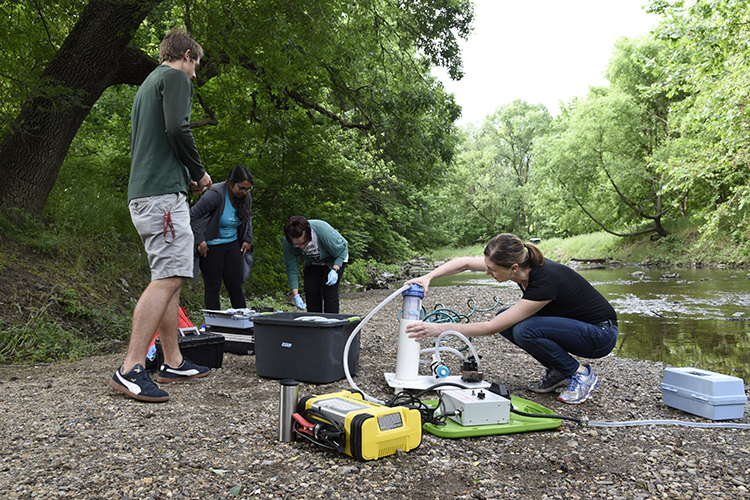By Emily Kovach
It wasn’t long ago that a budding environmentalist had only a handful of choices in higher education. But about a decade ago, this all began to change. As sustainability became a major cultural watchword, many students—some new to academia, some returning after losing jobs—were searching for a modern kind of major, and the stage was set for a big boom of green-leaning college programs. Companies and corporations were running their own parallel campaigns at the time, aggressively hiring newly minted sustainability experts to help improve operations.
“It’s important to note that the drive to sustainability comes from student interest as well as industry drivers. Students enter the university with as strong an interest in design for the environment as design for communities,” says Kate Wingert-Playdon, associate dean and director for Architecture and Environmental Design at Temple University’s Tyler School of Art.
Yvette Bordeaux, Ph.D., the director of Professional Programs in Earth & Environmental Science at the University of Pennsylvania, remembers the heady times during 2010 and 2011 when the field was taking off.
“Sustainability was the new up-and-coming field. It was our biggest concentration in a while in terms of students in the group, and jobs were all over the place,” she says. “For a while, big companies like Johnson & Johnson were hiring these folks to come in and tell them what they need to do to improve sustainability.”
Dr. Bordeaux notes that just as those corporate jobs began to dry up, as companies began to hire internally, jobs at college campuses, as Sustainability Coordinators and the like, were rapidly growing. Corporations did eventually start hiring sustainability grads again, she notes, as they started to realize how green practices can positively affect their bottom lines.
“I think at first there was a lot of greenwashing, but now companies realize there’s a lot of benefit from these sustainable practices,” she says. “It took a change in attitude on our side, too, to talk to them on their level, which is business, not just environmentalism.” As UPenn has evolved with the trends of the field, it has added more business-focused and data analytics classes to its sustainability programs.
Robert Fleming, architect, professor and director, M.S. in Sustainable Design Program at Jefferson University, has also watched things shift since his program was founded (at then Philadelphia University) 11 years ago, and he believes the field still has a ways to go.
“The programs are not focusing enough on adaptation and resilience. Even if we stopped emitting greenhouse gasses today, the effects of climate change would still be with us for years to come,” he says.
The Greater Philadelphia region is home to dozens of institutions of higher learning, nearly all of which offer a plethora of sustainability programs. The following pages include six of the strongest programs (plus some honorable mentions) to consider.
Temple University (MS in Environmental Health)
Protecting our health in a toxic world
This is a slightly newer discipline, so let’s start with a definition. The National Environmental Health Association outlines environmental health as, “the science and practice of preventing human injury and illness and promoting well-being by identifying and evaluating environmental sources and hazardous agents and limiting exposures to hazardous physical, chemical, and biological agents in air, water, soil, food, and other environmental media or settings that may adversely affect human health.”
Temple’s M.P.H. Program in Environmental Health, held mostly on its main campus in Philadelphia, prepares graduates for practice-oriented careers in environmental health and management. The school puts extra emphasis on environmental factors and environmental policy that affect the health and sustainable environments of communities. Both full- and part-time students are welcome to the program, which usually takes between two and four years to complete.
Interdisciplinary coursework, research, and face-to-face interactions widen students’ perspectives to the complicated and evolving state of public health. It can also be taken as part of nine dual M.P.H. degree programs at Temple, including a J.D./M.P.H., with Temple’s Beasley School of Law, and a M.S.W./M.P.H. with the School of Social Work.
The emerging field of environmental health requires technical and professional skills to face and solve public health issues. Course work includes environmental toxicology, environmental health, epidemiology and biostatistics.
Resa Jones, chair of the department of Epidemiology and Biostatistics, says, “Temple students are able to gain hands-on experience in environmental labs with faculty who have practical experience working with various groups such as non-governmental organizations, the Environmental Protection Agency and the Philadelphia Water Department.”
University of Pennsylvania (Master of Landscape Architecture)
Preserving our ecology while population grows
This internationally renowned program is recognized as a bastion of innovation and leadership in the field of ecological design and planning. UPenn’s Master of Landscape Design—part of PennDesign—was founded in 1924. Thirty years later, Professor Ian McHarg, author of the critically acclaimed book Design With Nature, revitalized the program, and it is his vision that the school seeks to carry on to this day. (In fact, PennDesign is celebrating the 50th anniversary of Design With Nature with an international exhibition, Design With Nature NOW, slated for June 2019.)
McHarg was succeeded by Program Chair Anne Whiston Spirn, who worked in Philadelphia neighborhoods to develop what she called “landscape literacy,” understanding where people are in relation to the space and time of the landscape. The program was then headed by the preeminent garden historian John Dixon Hunt, then James Corner, now best known for designing the High Line in New York City. The school is now chaired by Professor Richard Weller, an accomplished designer with projects under his belt like the National Museum of Australia, whose current research focuses on global urban growth and its conflicts with biodiversity.
“The [program’s] emphasis is on design and how design can help solve complex problems regarding land use, infrastructure, and communities . . . . Right now, we are looking at a map of North America and asking where the next 100 million people who are predicted to be added to the population will live,” Weller says. “The faculty are all extraordinary and working on big, complicated issues such as how we retreat from and learn to live with sea-level rise, new landscapes of energy production, informal urban growth in South and Central America and rapid urbanization in India and China.”
A diverse body of students pursue diverse solutions to complex problems, with a combination of curriculum sequences: the Design Studio, Workshop, Theory and Media. The McHarg Center for Urbanism and Ecology is the department’s flagship research center, and the school publishes two biannual journals devoted to advancing ideas and critical inquiry in Landscape architecture: “Scenario” and “LA+.”
University of Delaware (B.S., M.A., and Ph.D. in Energy and Environmental Policy)
Approaching energy production without the biases of industry
The U of D is home to a staggering number of environmentally focused programs, from the Ph.D. in Water Science and Policy to the Graduate Certificate in Socially Responsible Sustainable Apparel Business. But the ENEP program, located in the School of Public Policy and Administration, and which grew out of the Center of Energy and Environmental Policy (ENEP), was one of the earliest academic research
and teaching centers in the nation with this focus and the first Ph.D. and master’s degrees in the combined field of energy and environmental policy in the United States.
“At the heart of ENEP is an internationally diverse faculty and student body working critically and analytically on issues of climate change, energy transformation, renewable and nonrenewable energy options, environmental justice, smart cities and sustainable development,” says Syed Ismat Shah, director of the Energy and Environmental Policy Program and professor of physics, astronomy, materials science and engineering.
ENEP offers multidisciplinary academic degrees, with coursework in economics, geography, political science, engineering, urban planning and environmental studies.
Shah notes that the University’s geographic location on the Delmarva Peninsula offers unique research opportunities in energy and environmental disciplines.
“With essentially no native energy generation and complete dependence on power bought from adjacent states, Delaware has the opportunity to choose its energy sources and its level of commitment to using green power,” he says. “Policy issues related to energy selection, and dealing with the consequences of these selections, are complex and offer incredible academic research opportunities and on-hand experiential learning possibilities.”
Each program requires a wide range of courses, from geography, economics, biological sciences, civil and environmental engineering and more. The doctoral degree might include Micro and Macroeconomic Theory, Special Analysis of Natural Resources, Regional Watershed Management and Solar Energy Technology and Applications.
Daniele Poponi, a 2018 Ph.D. graduate from the ENEP program says, “The interdisciplinary nature of the program and the rich offering of courses allowed me to acquire strong quantitative skills, while at the same time to sit in courses on ‘high-level’ policy and political economy issues. This combination was highly valued by my past and current employers (the International Energy Agency and the European Commission).”
West Chester University (Urban and Environmental Planning B.S. and Master of Urban and Regional Planning)
Mapping out a sustainable neighborhood, region and world
Both the bachelor’s and master’s degrees at West Chester University are relatively new: the Bachelor of Science in Urban and Environmental Planning was launched in 2016 in the Geography & Planning Department in the College of Business and Public Management. In 2017, the Geography & Planning Department launched the new Master of Urban and Regional Planning (MURP) graduate degree. May of 2018 marked the first MURP degree awarded to Katelyn Thompson.
Both programs are meant to prepare students for the role of professional planners, who often have immense influence on neighborhoods, regions and metropolitan areas.
The MURP program, which is aligned with the standards of the Planning Accreditation Board (PAB) of the Association of Collegiate Schools of Planning (ACSP), requires nine required core courses and six or seven elective courses. The required courses include geography classes, such as Quantitative Methods and Geographic Information Systems, and planning classes, like Planning Law and Land Use Planning.
WCU also offers post-bachelor certificate programs in Urban and Regional Planning (18 credits) and Geographic Information Systems (12 credits), which is also available to take online.
The B.S. program offers a broad range of core classes, like Planning History, Theory & Ethics and Computer Cartography to electives that allow students to follow their individual interests, such as Planning for Resilient Communities and Natural Disasters and Sustainable Living.
“While many professional planning programs within the region are situated within schools of design, we believe that ours is unique due in part to our institutional placement in the Geography & Planning Department, which is located in the College of Business and Public Management,” says Chair of the Geography & Planning Department and Professor of Planning Dorothy Ives Dewey, Ph.D., AICP, PP. “Our program is designed to build on the core strengths of the department, which include a focus on geospatial technologies and environmental analysis.”
Although these are both new programs at WCU, they’ve already become popular choices for environmentally minded students who are looking to apply their education to urban, population-dense communities. The university reports that 15 students have already graduated from the undergraduate program and have continued on a graduate programs.
University of the Sciences (Environmental Science Major)
Connections in the community, and a state-of-the-art lab
Tucked into a southwestern corner of West Philadelphia, University of the Sciences has earned a reputation as a pharmacy college since its founding in the 1820s. Though its College of Pharmacy is still its primary draw, the university has expanded to offer more than 30 programs. After a rebranding effort in 2010 and capping tuition at $25,000 per year for undergrad programs in 2017, USciences has taken a firmer place among the other prestigious educational institutions in Philadelphia.
One major that USciences is now known for is its undergraduate program in Environmental Science. Students are given access to real-world knowledge through a science-focused curriculum, replete with specialty courses led by faculty who also work in the field. The McNeil Science and Technology Center, a state-of-the-art lab, provides wide-ranging resources for students, as well as many fieldwork and internship opportunities.
Kevin C. Wolbach, the assistant dean of UScience’s Misher College of Arts and Sciences, and also the coordinator of the Environmental Science program, notes that the broad background that the B.S. in Environmental Science provides students with ultimately helps them pursue graduate studies or their first job after graduation.
“The program provides small class sizes, weekly field experiences, and courses taught by experts in their discipline,” he says. “The ability to combine an interest in environmental science and human health is unique to the Environmental Science program at USciences.”
Kelly Wright, a USciences alumnus (Class of 2002), now works as senior manager of Environmental Relations at Johnson Controls, Inc, a multinational conglomerate headquartered in Cork, Ireland, that produces automotive parts such as batteries, and electronics and HVAC equipment for buildings. She echoes Wolbach’s claim that the university’s rigorous academic programming led to her quick post-graduation employment.
“My degree in Environmental Science from USciences opened professional opportunities for me within months of graduation,” she says. “And the dedicated faculty and challenging curriculum laid the foundation for my career as an environmental engineer.”
For those who want to stay in academia a bit longer, another appealing component of the program is the integrated graduate-credit program at USciences. Qualified undergrads who wish to pursue a USciences M.S. or Ph.D. can take up to 15 additional credits of graduate coursework at no extra cost.
Drexel University (Bachelor of Arts in Environmental Studies and Sustainability)
A humanities degree with a practical approach to saving the environment
Appealing to students who might have loved AP Bio but aren’t quite ready to delve headfirst into a classical science path in college, Drexel’s Bachelor of Arts in Environmental Studies and Sustainability Program offers a humanities-driven approach to the layered problems surrounding the environment. Its goal is to address the “complex social, cultural, economic and political fac
tors that influence society’s understanding and adoption of these solutions.” A pioneer in the field, Drexel was one of the first universities in the United States to found an undergraduate environmental science degree in the late 1960s.
In 2014, the program was reassigned to the Academy of Natural Sciences, with a new name, Environmental Studies and Sustainability (previously it was called just Environmental Studies), and a revamped curriculum, which includes the option for specialized study tracks including Policy, Government and Business, Social Awareness and Action, and Scientific Inquiry. Under the leadership of Carol Collier, formerly the executive director of the Delaware River Basin Commission for 15 years, the program was developed with a distinctly hands-on approach.
Part of this is due to Drexel’s much-lauded co-op structure, where undergraduate students attend the university for five years, spending a few semesters placed at internships in their fields, as well as time in the classroom. By the time they’ve graduated, students have had multiple forays into the working world, to gain experience and try out various aspects of their field of study.
The other component is the program’s faculty, many of whom are what David Velinsky, Ph.D., department head, Biodiversity, Earth and Environmental Science & VP for Academy Science, calls “professors of practice.”
“These are people who might work for the DVPA, someone who’s in [environmental] law, maybe people from Delaware Valley Regional Planning Commission… it’s not just academic professors,” he says. “You get the theory, but a lot of the classes are taught by people in the field, urban planning or the EPA field—that’s what makes our program a little bit different.”









How could you forget about Villanova University’s Master of Science in Sustainable Engineering?